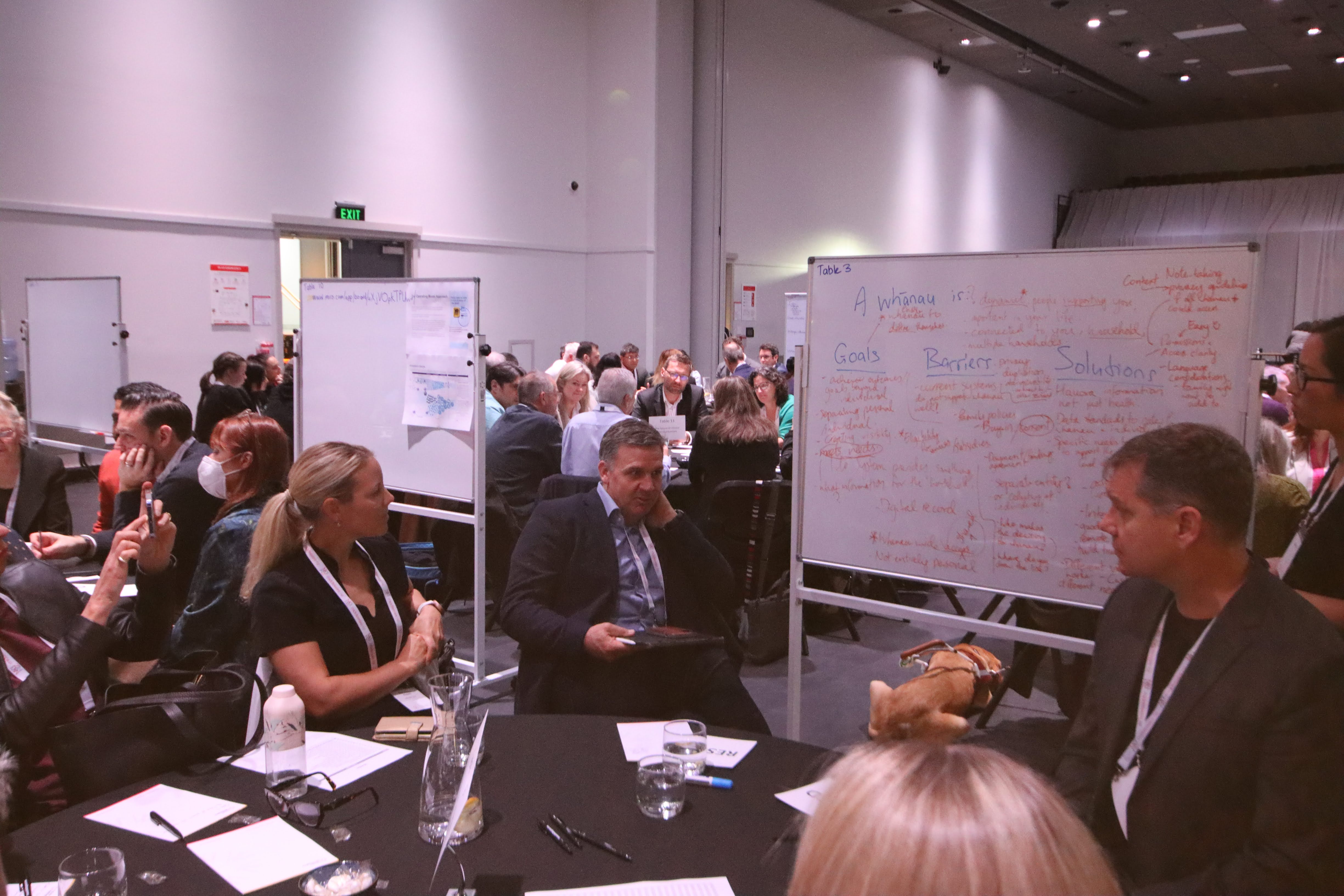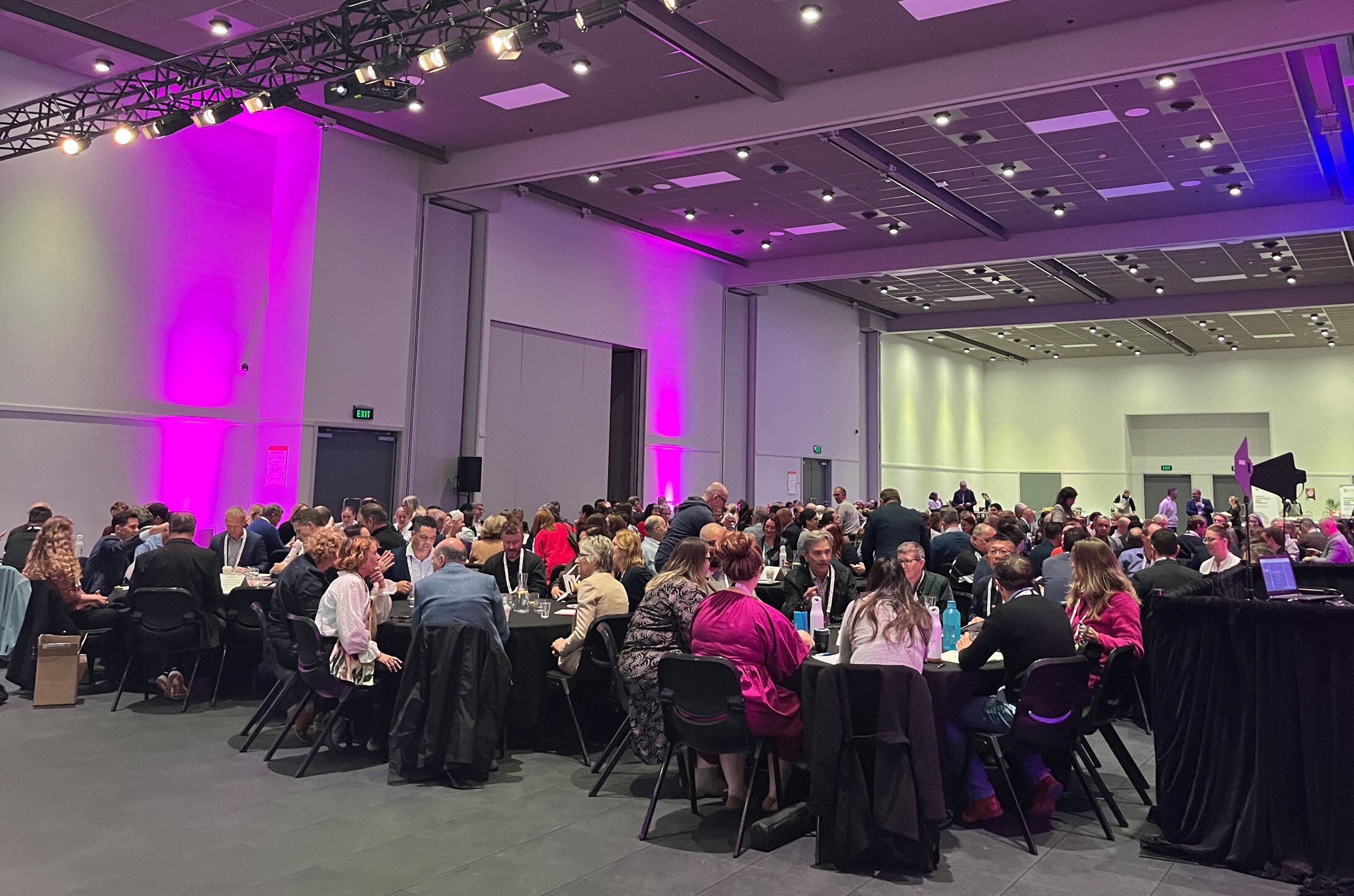Introduction
We ran a discussion table at the HINZ Leadership Summit, held in Wellington, NZ, on 5 and 6 September 2022. The event was attended by people from across the health sector in Aotearoa. Our topic was 'The Future of Whānau-centered Care Management'.
Our goal was to hear participant' thoughts on what whānau-centred care means to them, what the benefits of whānau-centred care are, what the barriers to implementation are, and what eventual solutions could look like.
To help structure the discussions, we divided the sessions into four main sections:
-
- What is whānau within the context of whānau-centred care?
- Goal and opportunities for a whānau-centred care solution
- Barriers to implementation
- Solutions
Summary
We felt that the kōrero over the course of the summit was valuable and engaging. Many participants had strong views and it is clearly a subject that some people care deeply about.
The concept of whānau-centric care can have different meanings, ranging from people an individual wants as support at a time of crisis to a household. Listening to people, my impression is that this has as much to do with context as personal opinion. Staff on a hospital ward managing the palliative care of a patient with attendant whānau have quite different concerns to a team working with a household to improve their housing situation. Ideally, a whānau-centric system would be able to support all relevant circumstances.
There seemed to be general agreement that better outcomes for people could be achieved with a whānau-centric approach, with acre seen as being more holistic in nature and people better empowered to help themselves and being more engaged in their care.
Privacy concerns and cultural inertia are certainly seen as barriers to implementation. It was also acknowledged that a broad move to whānau-centric care would also require a system-wide rethink, with whānau recognised as entities in their own right.
Ideally, technological system changes to meet the needs described would require a person/whānau poartl to allow people to securely view and control access to relevant records. Interoperability across the sector is also seen as important.
It would appear that a whānau-centric health sector would offer significant benefits, but implementation would not be trivial and wide implementation would require a measured and iterative approach.
.jpg?width=797&height=504&name=pexels-alexandr-podvalny-3036405%20(1).jpg)
What is a whānau within the context of whānau-centred care?
We were struck, not only by the breadth of answers to the questions of what whānau is within the context of whānau-centred care, but also the depth of feeling attached to the answers. This is a subject that people feel passionate about!
There were three main categories of answers to this question:
-
- A circle of people who offer [me] support
- Household/nuclear family
- Extended family
It was also brought up that the definition of whānau could be any of these, depending on context.
A circle of people who offer support
What came through strongly was that many people saw their whānau as the people they want around them as support. People used terms such as:
-
- 'My people'
- 'People supporting you'
- 'People I want to support me'
- 'Inner circle'
Household/nuclear family
Some people spoke of their whānau as being the people they lived with, who they identified as family. Participants referred to:
-
- 'Household'
- 'Family'
- 'Recognised entity'
Extended family
One's extended family was also seen as a definition of whānau, including hāpū and iwi. The genealogical component of health was brought up a few time. It was acknowledged that the definition here could vary depending on cultural background. Phrases included:
-
- 'Hāpū, iwi, genealogy'
- 'Depends on culture'
Goals and opportunities for a whānau-centred care solution
There was pretty strong consensus that whānau-centred care offered important benefits for people. The main themes included:
-
- Improved outcomes
- Improved ability to deliver care
- Empowerment of people and whānau
- Improved data capture
Improved outcomes
From the perspective of improved outcomes, people referred to taking a more holistic view of people's health, looking beyond presenting symptoms to include people's wider needs and environment. Examples of what participants said are:
-
- 'Meet four cornerstones of health'
- 'Holistic view of [a] person's health'
- 'People looking after each other'
- 'Opportunity for equitable outcomes'
Improve ability to deliver care
It was felt that working with whānau would improve the ability of health workers to deliver care. Better informed decision making, support for interactions, opportunities for greater efficiency, and care planning were discussed. Some examples included:
-
- 'Give workers better information to inform care'
- 'Ease to involve people and communicate with them'
- 'Understand where opportunities are to access support'
- 'Better informed decisions due to whānau being involved in care'
Empowerment of people and whānau
Personal empowerment was a particularly strong theme in discussions. It was felt that it is important that people feel comfortable and in control of their care, that people should be enabled to help themselves, and that whānau should be worked with to come up with solutions. Common quotes from participants included:
-
- 'People feel comfortable and in control'
- 'Trusted people can support and access information'
- 'Empowered whānau'
- 'Knowledge systems - collective knowledge is power'
Improved data capture
Data was a less dominant theme in the discussions, but opportunities for better data capture were identified. Examples included:
-
- 'Be able to identify trends and make decisions'
- 'Data to identify gaps in service'
- 'Capture social determinants'
- 'Identify gaps in care of whānau'
Barriers to implementation
As with the previous sections, a small number of core themes emerged when discussing barriers to implementation: The main topics included:
-
- Policy and privacy rules
- Lack of interoperability
- Lack of systems that support whānau-centric care
- Cultural inertia
- Lack of funding/resources
Policy and privacy rules
Concern about maintaining privacy rules was brought up consistently, with the main worry being a lack of clarity about what can be shared, and who decides what can be accessed. There was a feeling that policy will need to be updated to provide staff with the certainty they need to work in a whānau-centric way. Examples of comments made include:
-
- 'Who makes the decision for whānau?'
- 'Where do you draw the line between whānau and the individual?'
- 'How do you decide which agencies get access?'
- 'Undefined boundaries'
Lack of interoperability
Some of the conversations seemed to be less about whānau-centric care per se, and more about what an ideal health and social care ecosystem in Aotearoa could look like. The lack of interoperability was seen as a major barrier to efficient delivery of care. Some examples included:
-
- 'Data siloes'
- 'Corporates selling rather than collaborating'
- 'No connection between providers'
- 'Lack of interoperability'
Lack of systems that support whānau-centric care
It was acknowledged that for whānau-centric care to be possible, that systems would have to support that. Much of the commentary overlapped with concerns about privacy and consent, with it being necessary to separate the records of individuals from whānau records. Participant comments included:
-
- 'Current systems do not support whānau well'
- 'Separating individual information from whānau'
- 'How is the relationship created?'
- 'Lack of whānau-centric approach to health and identity management'
Cultural inertia
Another barrier discussed at some length was cultural inertia, with a potential lack of buy-in or acceptance by both workers and people. Fear, distrust, and a lack of social acceptance were common themes. Some comments included:
-
- '[Lack of] Buy-in'
- 'Distrust of care providers'
- 'Communication and comprehension'
- 'Processes and ingrained systems'
Lack of funding
A lack of funding to pay for required system changes and implementation was discussed. Examples included:
-
- 'Lack of resources'
- 'Funding'
- 'Lack of access to digital services'
- 'Shortage of skilled staff'
Solutions
On the whole, participants had many clear ideas about what a whānau-centred care solution for Aotearoa could look like.
The ideas can be broken into six categories:
-
- Whānau-centric data standards
- Strong interoperability
- Control by people and whānau
- Whānau-centric systems
- Policy
- Design approach
Whānau-centric data standards
It was noted that for Aotearoa to work in a whānau-centric way, that data standards would have to updated to accommodate this. Suggestions included:
-
- 'Data standards to cater for whānau'
- 'Whānau NHI'
- 'Data governance'
Strong interoperability
There was a strong message that, ideally, care should be provided in a coordinated way, with appropriate sharing of care and information between providers and systems:
-
- 'Data not held hostage'
- 'Interagency referral ability'
- 'Systems able to connect'
- 'Meaningful data exchange'
Control by people and whānau
Empowering people and whānau to easily and appropriately access their own records, provide and remove consent, and control who has access to their information. This would necessitate client/whānau apps. Suggestions that summarise the conversations include:
-
- 'Good client facing app'
- 'Ability for people to opt in support [access] to others'
- 'Built in consent process'
- 'Consent and removal of consent easy'
- 'Visibility of what is being recorded'
- 'Ability to transact on behalf of others'
Whānau-centric systems
Participants in the conversations had many ideas of what a whānau-centric system should look like. Examples included:
-
- 'Hauora information - not just health'
- 'Enables coordination of care'
- 'Levels of decision making and involvement that can be set up and delegated'
- 'Topic dependent level of access'
- 'Te Whare Tapa Whā'
- 'Ability to measure whānau outcomes'
- 'Different views for whānau and workers'
- 'Way to capture whānau news and goals at a high level'
- 'Patient focussed portal'
Policy
It was suggested that mandated national level guidance and policies will be necessary.
Design approach
It was acknowledged that the design process is important, with co-design seen as being particularly important. Key comments included:
-
- 'Build it for the aunties'
- 'Involving the right people on the journey'
- 'Co-design - not just a tick box'
- 'Shared/collective approach'






